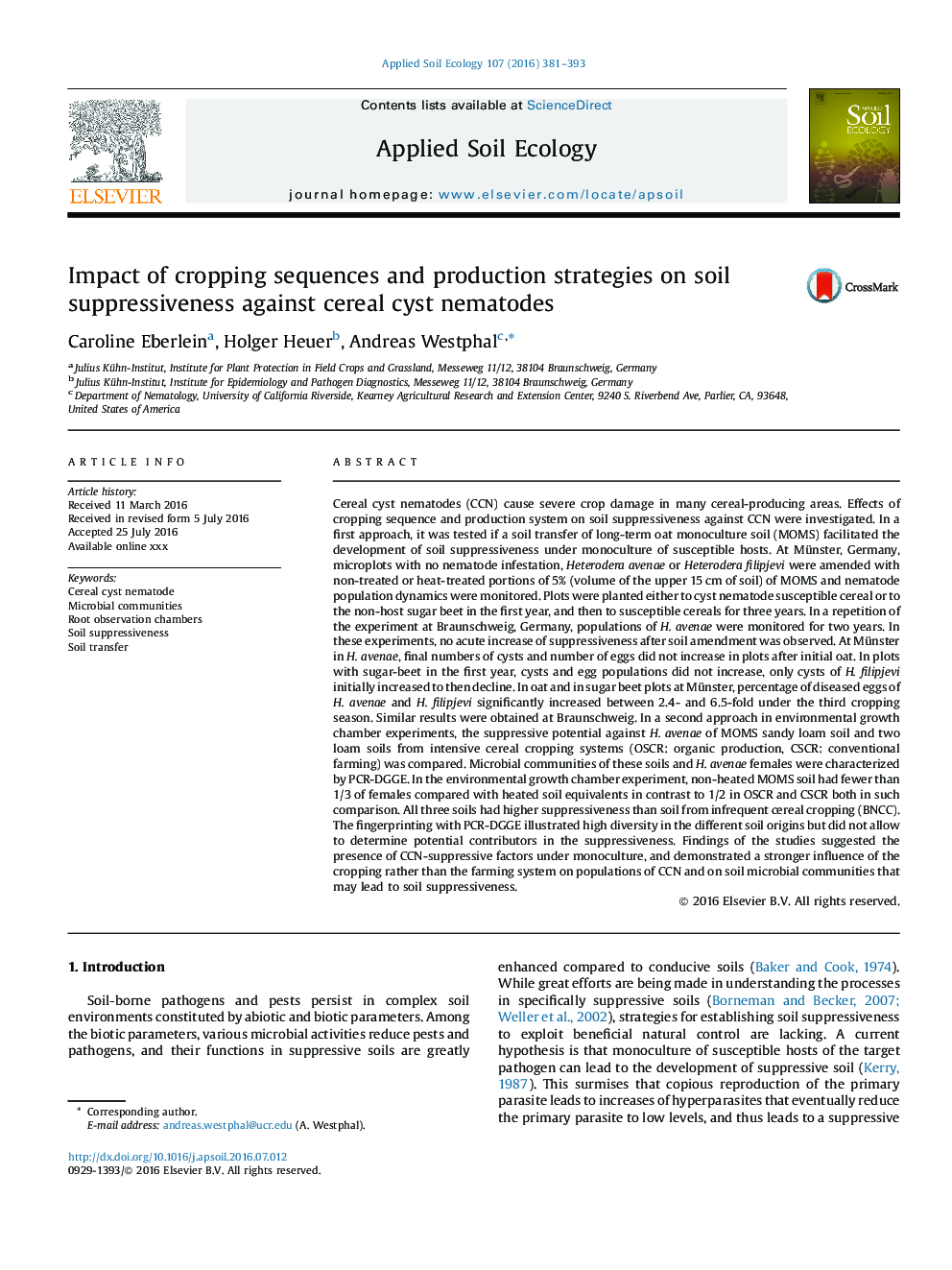| کد مقاله | کد نشریه | سال انتشار | مقاله انگلیسی | نسخه تمام متن |
|---|---|---|---|---|
| 6297666 | 1617776 | 2016 | 13 صفحه PDF | دانلود رایگان |
عنوان انگلیسی مقاله ISI
Impact of cropping sequences and production strategies on soil suppressiveness against cereal cyst nematodes
ترجمه فارسی عنوان
تأثیر توالی های کشت و استراتژی های تولید در برابر سرکوب گرایی در برابر نماتدهای کیست های غلات
دانلود مقاله + سفارش ترجمه
دانلود مقاله ISI انگلیسی
رایگان برای ایرانیان
کلمات کلیدی
نماتد کیست غلات، جوامع میکروبی، اتاق بازرسی ریشه، سرکوبگر بودن خاک، انتقال خاک،
موضوعات مرتبط
علوم زیستی و بیوفناوری
علوم کشاورزی و بیولوژیک
بوم شناسی، تکامل، رفتار و سامانه شناسی
چکیده انگلیسی
Cereal cyst nematodes (CCN) cause severe crop damage in many cereal-producing areas. Effects of cropping sequence and production system on soil suppressiveness against CCN were investigated. In a first approach, it was tested if a soil transfer of long-term oat monoculture soil (MOMS) facilitated the development of soil suppressiveness under monoculture of susceptible hosts. At Münster, Germany, microplots with no nematode infestation, Heterodera avenae or Heterodera filipjevi were amended with non-treated or heat-treated portions of 5% (volume of the upper 15Â cm of soil) of MOMS and nematode population dynamics were monitored. Plots were planted either to cyst nematode susceptible cereal or to the non-host sugar beet in the first year, and then to susceptible cereals for three years. In a repetition of the experiment at Braunschweig, Germany, populations of H. avenae were monitored for two years. In these experiments, no acute increase of suppressiveness after soil amendment was observed. At Münster in H. avenae, final numbers of cysts and number of eggs did not increase in plots after initial oat. In plots with sugar-beet in the first year, cysts and egg populations did not increase, only cysts of H. filipjevi initially increased to then decline. In oat and in sugar beet plots at Münster, percentage of diseased eggs of H. avenae and H. filipjevi significantly increased between 2.4- and 6.5-fold under the third cropping season. Similar results were obtained at Braunschweig. In a second approach in environmental growth chamber experiments, the suppressive potential against H. avenae of MOMS sandy loam soil and two loam soils from intensive cereal cropping systems (OSCR: organic production, CSCR: conventional farming) was compared. Microbial communities of these soils and H. avenae females were characterized by PCR-DGGE. In the environmental growth chamber experiment, non-heated MOMS soil had fewer than 1/3 of females compared with heated soil equivalents in contrast to 1/2 in OSCR and CSCR both in such comparison. All three soils had higher suppressiveness than soil from infrequent cereal cropping (BNCC). The fingerprinting with PCR-DGGE illustrated high diversity in the different soil origins but did not allow to determine potential contributors in the suppressiveness. Findings of the studies suggested the presence of CCN-suppressive factors under monoculture, and demonstrated a stronger influence of the cropping rather than the farming system on populations of CCN and on soil microbial communities that may lead to soil suppressiveness.
ناشر
Database: Elsevier - ScienceDirect (ساینس دایرکت)
Journal: Applied Soil Ecology - Volume 107, November 2016, Pages 381-393
Journal: Applied Soil Ecology - Volume 107, November 2016, Pages 381-393
نویسندگان
Caroline Eberlein, Holger Heuer, Andreas Westphal,
